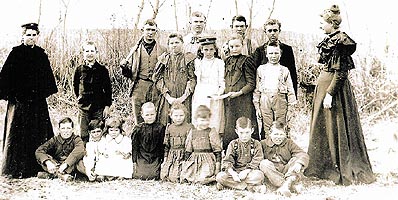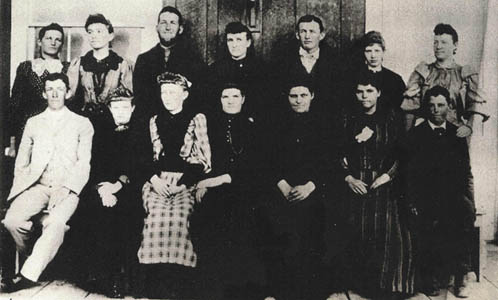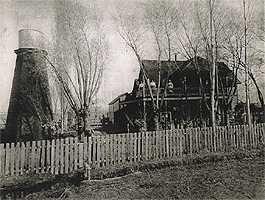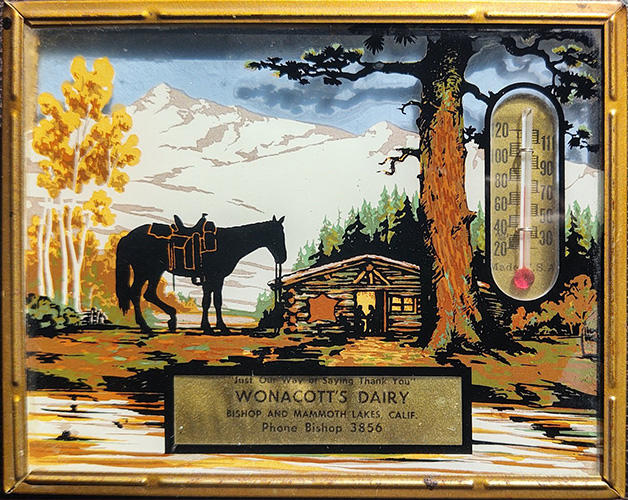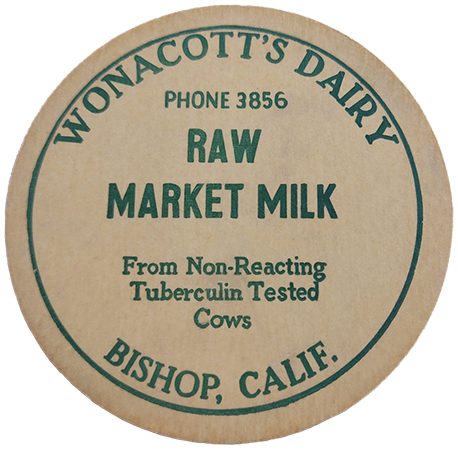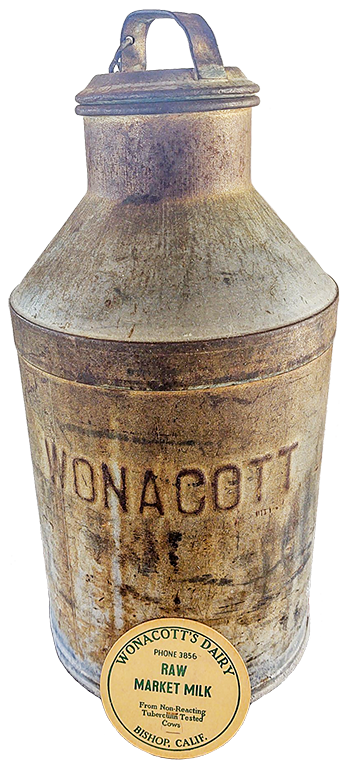











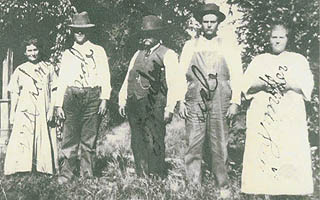 L to R: Rachael Huckaby Wonacott, Forrest Wonacott, Charles William Wonacott, Dwight Wonacott, Evangeline Wonacott Backert taken 1917 at Old Ranch in Bishop The Wonacott Family of Bishop |
|
All text references to "I" or "my" are personal commentary by Forrest (Bud) Backert. See USE NOTICE on Home Page. |
The Wonacott Family, California Pioneers
by Carol Backert
|
|
| George
and Emily Huckaby and family and Charles Wonacott and wife Rachel
(Huckaby) came from the east in a wagon train. They chose the
Owens River Valley as their ultimate goal and arrived in 1874
at what was then known as the Love Bridge, now ridges. George
homesteaded acreage on Dixon Lane and one tall white silo cylinder
is a marker standing just west of U.S. Highway 6 north of Bishop. Both families lived on the ranch. Then the Huckaby family sold the ranch to Charles Wonacott and moved to land beyond the Owens River until eventually moving to Laws. (This isn't quite the story, actually Rachel's parents, Hiram and Louvicey Huckaby owned the ranch. Hiram died and she left the ranch to the children, James, George and Rachel. And her husband Charles bought out the two Huckaby boys.) George (Huckaby) and Emily (his wife Emily Smith) were the parents of Florence (Huckaby) Smith. Florence Huckaby married Joe Smith, a different Smith and she was in Laws for years. She was postmistress until just before her death and her little post is at the museum at Laws. I always called her aunt Florence, but she wasn't an aunt.) Wonacott built a two-story home on Wonacott Lane, as earlier known. He teamed between Candelaria, Carson City and Bishop Creek and was also busy as carpenter helping build several schools and some of the bridges over the Owens River. Recently, a pretty, ornate medal the size of a dollar was discovered near the Wonacott, silo by use of a metal detector. The embossed words, "This medal of excellence to Charles Wonacott for a cartridge loader, 1877. The historic piece indicates a sort of contest unknown in 1877. Charles and Rachel raised eight children. One son, Don, managed the farm in later and built the silo. (Charles sold the ranch to his son Don on August 12, 1924. His name is noted in the Inyo Creamery Papers. The Wonacott children had to hike salt grass fields to attend Riverside school to the north. (The school / the ranch, Charles donated the one acre to the school district for ''as it shall be used for school purposes"). In those days there were no fences from our place clear to town" as told by Albert W. (Bob) Wonacott. Bob liked to tell of the few years he lived in Nevada. His father was then the town undertaker and Bob was employed as a teamster. He drove teams the long trip to and from Sodaville, which was then the end of the railroad from Carson and points north. The route used by stages and the long teams was across the flats by Millers and over the Monte Carlo Range with two night stopovers. Another interest of Nevada's early days told by Bob was a mode of transportation between Tonopah and Goldfield after the T & G Railroad was completed. Autos were equipped with flanged wheels so they could run on the tracks between train schedules. Passengers were hauled at a cost of $30 per round trip. Holiday time parties would "charter" the rail traveling cars for a special event at Goldfield for a sum anywhere from $30 to $50. In 1908 Bob and Carrie Thompson were married. They raised three children, Thelma, Thomas and Barbara Jean. The family was long known for their dairy business near Bishop and also in the Mammoth Lakes area. Milk and cream were always delivered to the door with a cheerful greeting or a bit of news. Bob and Carrie were very hospitable people Bob welcoming friends with a reminder of early days, "put your horses in the corral and bring in your bedrolls" Family history from the late Bob and Carrie, (Thompson) Wonacott. |
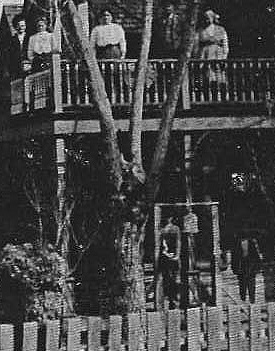 |
|
On the first floor the figure on the left is Forrest Wonacott, the uncle I was named after. The boy on the right is Dwight Wonacott he too was my uncle. |
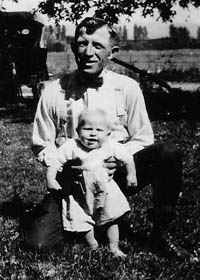 Frank Backert and son Forest Xavier Backert |
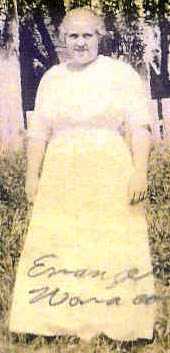 Evangeline Wonacott |
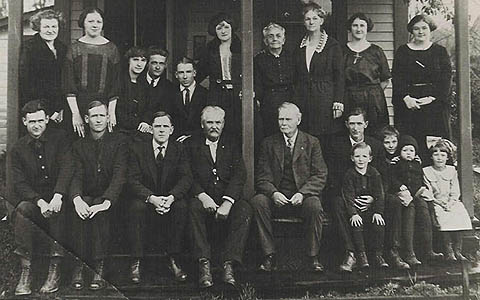 The Wonacotts in 1922 |
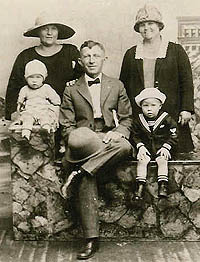 Bud Backert Family 1922 |
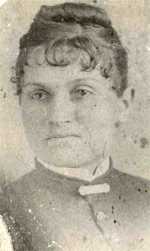 Rachael Lettitia (Huckaby) Wonacott |
|
|
|
|
| The
Huckaby family has been traced back in Virginia to about 1720.
This work done by Dennis Huckaby, a grandson of George Washington
Huckaby, who is currently living in Scottsdale, Arizona. The
Virginia Huckaby's are probably related to other Huckaby's that
research has turned up in Georgia and Louisiana, there are several
spelling variations, but no direct connection has been found. Our Huckaby family, or at least parts of it, left Virginia sometime after 1800 and went to Tennessee. It looks as if they spent the Civil War there. Hiram Huckaby, the father of Rachel was born there in Campbell County in 1817 or 1813. He was married there in 1859. The Civil War began in 1861 and ended in 1865. From Tennessee the family moved to Illinois and from there to Missouri for a short time. On April 10, 1874 they left Independence, Missouri for California. There was a total of seventy-five in the party, it included Hiram Huckaby, Louvicey Hicks-Huckaby, his wife and Moses Smith and his wife Saphrona Herrill (Merrill?) Smith, George Washington Huckaby and his new bride Emily Smith. Charles Wonacott and Rachel Huckaby were married on June 16, 1872 in Osceola (Ritches Mill), Missouri so they were newly wed also, they were members of the immigrant train until it got to Laramie, Wyoming where Rachel's first child, Franklin died, and her second child Carrie Belle was born. The main party arrived in Bishop October.26, 1874, this according to Dennis (Chuck) Huckaby, but Rachel, her husband Charles, and the new baby Carrie didn't arrive in Bishop until November 1875. Rachel's third child, Don Lester, was born in Bishop December.21, 1876, her fourth child, Albert Warren (Bob), was born in Murphys in 1886. They returned from Murphys to Bishop and Rachel inherited one third of the Huckaby homestead, later the Wonacott ranch on Dixon Lane. She and Charles bought out the other heirs and owned the ranch themselves. When Charles bought out the other Huckaby's he had Rachel quit claim her share to him, including 4 cows and five calves. Don't know why this was done this way, especially in a community property state, but it makes interesting speculation. Rachel had two brothers, James, who never married and George Washington Huckaby, who married Emily Smith, in Missouri, before coming to California. Emily and George had eleven children: James, Franklin, Charles, Will, Claude, Ray and Raymond the twins, Alice, Ethel, Ella and Florence. Most of them lived in the Laws area and went to school in Laws and Bishop. Emily ran a Hotel in Laws (Dennis Huckaby said he was born in it), Claude had a pool room and a dance hall there. George and his wife Emily owned several pieces of property there. There is no town of Laws now, not really. The Railroad Museum is there, which is really something worth any of the family seeing, there is a house or two, a commercial plant, a movie set, you might find some concrete work with the name A.O. Adams imprinted in it. The post office that Florence Huckaby-Smith took care of for so many years has been moved to the museum grounds. But really there is no Laws anymore, no ranches around there; no ditch companies bring water to the fields. When you go there you aren't going to see much of anything and you will probably think that Laws is a pretty desolate place to live, no one would want to make a home there or to raise children there, it is just so much sand and sage brush. Near town is the Owens River, now a kind of brackish looking stream, wouldn't drink the water, for sure. Don't care too much to swim in it anymore. But there was a time. It was long ago, in the seventies, no,no, the eighteen seventies, not the nineteen seventies, when the Wonacott's and the Huckaby's and the Smiths came to the Valley there was water, and the water made the Valley bloom. It is hard to believe that there were ranches and fields of grain and schools and stores and people with children, and yes, even signs of prosperity in the latter years as a reward for those who weren't afraid to pioneer the land. The clearest example I can give is the old silo on Dixon Lane (it used to be Wonacott Lane). It is easy to find. Go there. There used to be a home there, a barn, out buildings, an orchard, gardens and trees. It was a working ranch. Over on the other side of the ranch (the next road north) was the Riverside School where many of the Wonacott's and Huckaby's went to school, but now sage brush, sand, nothing. Doesn't even look like it could have ever been anything. It can't, not without the water. It is gone, Laws is gone. The worst part is that that what is left isn't nice and green or pretty. That all went when the water went. Most of the Owens River now flows in a big steel pipe. Go north of Bishop and on the left or east side of the freeway at the bottom of Sherwin Grade is a road that will take you to the Owens River Gorge, where Charles and Rachel had the saw mill, you can look at that nearly dry gorge and at the same time hear the Owens River rushing by in all its purity... in a big steel pipe. |
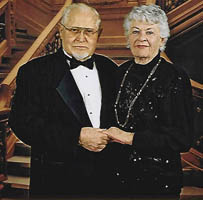 |
|
Photographs courtesy of Rick Olson archives |
|
|
|
George Brown - Owens Valley Pioneer | |
|
|
To the Top of Mt. Whitney | |
|
|
Independence | |
|
Keeler |
|
|
|
Aberdeen |
|
|
|
Keough's Radium Hot Springs |
|
Sign Guestbook View Old Guest Book Entries Oct 1999 - Feb 2015 (MS Word) |
 CONTACT the Pigmy Packer |
View Guestbook View Old Guest Book Entries Oct 1999 - Feb 2015 (PDF) |
